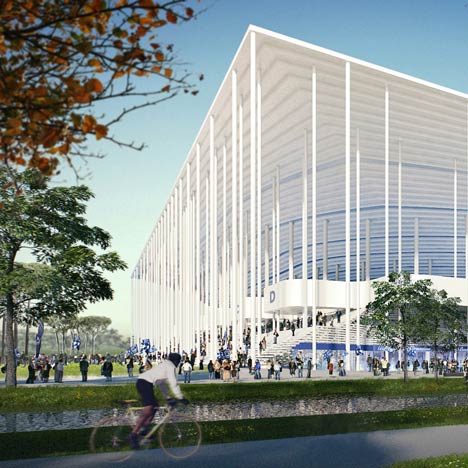
Stade Bordeaux Atlantique by Herzog & de Meuron
Swiss architects Herzog & de Meuron have designed a stadium for Bordeaux that will host football matches for Euro 2016.
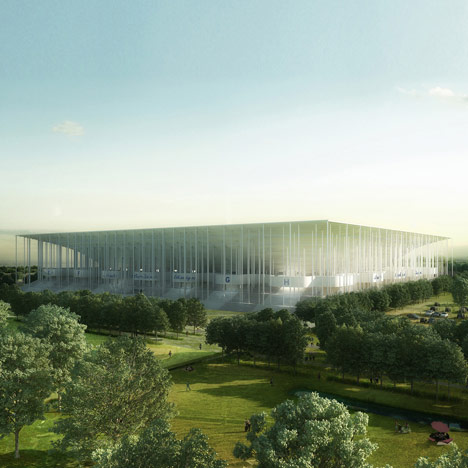
A "forest" of slender white columns will support the rectangular white roof of the Stade Bordeaux Atlantique, which will shelter up to 43,000 spectators.
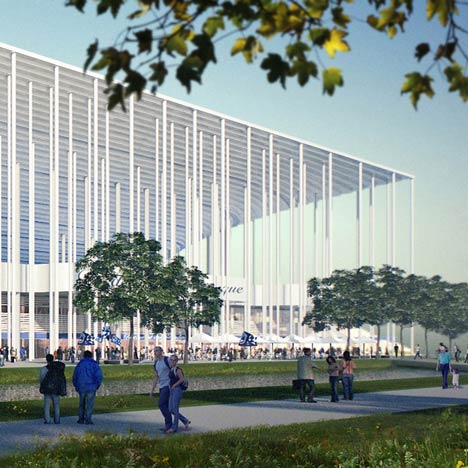
Natural light will filter into the stadium through glazed louvres in the roof.
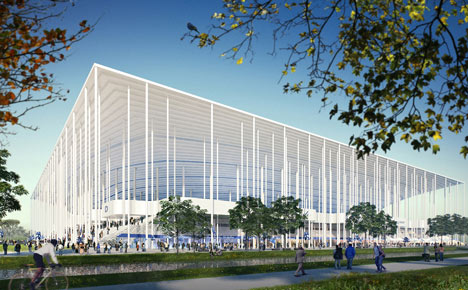
The base of the arena will house VIP lounges, players-spaces and media rooms, surrounded by food stalls amongst the columns.
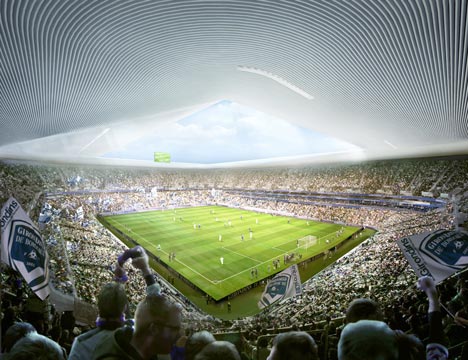
A public square in front of the building will form part of the proposed landscape improvements by French landscape architect Michel Desvigne.
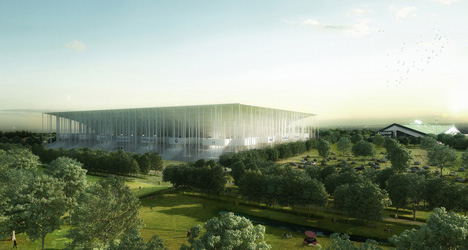
The stadium will be completed by 2015 and will also host rugby matches.
Herzog and de Meuron previously completed the National Stadium, Beijing for the 2008 Olympic Games - click here to see all our stories about Herzog & de Meuron.
Dezeen also recently featured three stadiums for the World Aquatics Championships in Shanghai - see all our stories about design for sports here.
Images are copyright Herzog & de Meuron.
Here is some more information from Herzog & de Meuron and Michel Desvigne:
Stade Bordeaux Atlantique, Bordeaux, France
2010 – planned completion 2015
Vision of a stadium
Our project for the new Bordeaux stadium is an expression of fundamentally new architecture. The pure shape of the volume, by contrast to its light and open structure, creates an at once monumental and graceful architectural piece elegantly suited to the grand landscape of Bordeaux.
Stadium architecture combines three constitutive elements: the bowl containing the game and its spectators, the concourse as the transitional element between the playing field and the outside surroundings and, finally, the overall appearance. Our approach is to reinterpret these three elements in light of the site-specific characteristics: the resulting architecture is thus one-of-a-kind, reflecting the intrinsic features of the site.
We aim to present an architectural object in which highest functional quality is combined with a unique identity. We are confident that allying these two criteria, functionality and strong identity, endows our project with an emotional dimension that the public can feel, and that is inextricably bound to the stadium’s traditional role of staging sports.
The bowl
Seating a maximum of some 43,000 persons, the bowl embraces the game area, its geometry affording optimal visibility for all, together with the maximum flexibility of capacity and usage.
The bowl consists in two superposed tiers divided into four sectors and protected from the elements by the roof. Consisting of a multitude of concentric strips, the ceiling’s homogeneous appearance guides the gaze to the playing field, while allowing sunlight to seep through thanks to the strips’ angle of slant. This open ceiling structure does not show through on the inside of the stadium, to avoid distracting the spectators’ attention.
Raising the bowl above ground level is a compact base integrating all the programmatic functions into a uniform and symmetrical volume. This plinth includes the VIP loges and salons evenly distributed east and west as well as media areas adjacent to the spaces dedicated to players.
The simplicity and pure lines of the architecture characterizing the bowl and its base guarantee a smooth flow of spectators and easy orientation.
The overall appearance
The bowl resting on its base is covered by an elegant roof which has an unusual rectangular shape. The choice of this pure and almost abstract form is the clearest and most efficient response to the site’s natural conditions, and to the main flow of spectators east-west.
This white rectangle seems projected earthwards thanks to the multiplicity of slender columns that shower down. A ribbon of food stalls and restrooms undulates through this forest of columns, brought alive by the movement of the crowd.
At once dense and light, this structure creates an evanescent rectangular volume from which emerges the sculpted and organic outline of the bowl.
In its specificity, this architectural concept confers a strong and unparalleled identity to the new Bordeaux stadium. Well anchored to its site, this elegant and diaphanous volume looks out onto the grand landscape its transparency revealing all the energy and activities which will fill this new symbol of the city of Bordeaux’s dynamism.
Herzog & de Meuron, 2011
Landscaping
The stadium’s implantation is linked to a particular situation, serving as a juncture between a high-quality natural setting to be reinforced to the north and, to the south, a structured urban periphery area in need of new development. Hence, any plans for the upcoming stadium must represent a basic step towards introducing the Secteur Nord Rocade tree belt, a project already foreseen by the city of Bordeaux’s landscape development plan.
Our proposal aspires to draw up a preliminary rendition of these future development plans. It reinterprets the tree belt’s exceptional features comprising rows of trees lining the main access ways. It defines an overall structure and organizes the various land plots in a grid.
The stadium’s surrounding areas (parvis, parking area, green corridor) belong to this language: organic tree lines serve as screens in a setting where, following the north-south orientation, they offer a variety of views while preserving a clear frontal view of the stadium’s facade. Surrounding the stadium, an entirely pedestrian public area is accessible from all sides.
The ground of the square around the stadium consists of three elements: grass-jointed concrete paving, natural lawn dotted with groups of trees forming open spaces and, facilitating stadium entry and exit, hot-rolled asphalt on surfaces around the stadium and defining the bus parking area to the east. The parking area to the north holds onto its for the most part mineral ground already anticipating the tree belt with its densely planted trees interspersed by plant beds.
These mixed area types set the stadium within a defined landscape, closely correlating the stadium site with its surrounding woodland setting.
MDP Michel Desvigne Paysagiste, 2011
Translation, Margie Mounier